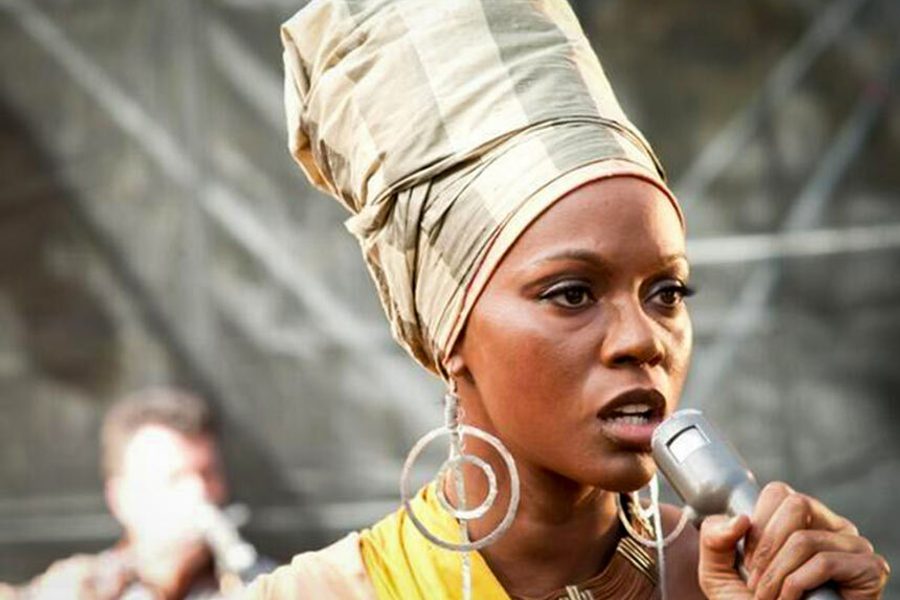
In May, the Nina Simone biopic Nina, starring Zoe Saldana and directed by Cynthia Mort, premiered at the Cannes Film Festival. But the director was unhappy with the version that debuted. Mort is suing the film’s British producers for allegedly cutting her out of the editing and decision-making process, in violation of her contract. Meanwhile, no date for a U.S. release has been set. All of this drama suggests that Nina is the bearer of some seriously bad karma.
Ever since on-set photographs of Saldana, made up as Simone, began circulating online last year, I have been convinced that the casting and staging of a light-skinned, straight-haired Dominican woman as a brown-skinned African-American woman with coarse, afro-textured hair is a representational flaw that poisons this entire film.
By putting Saldana in brownface, Afro wigs and prosthetic buck teeth, the producers of Nina have taken a conventionally lovely woman and made her ugly and grotesque, even as they have not made her look a damn thing like Simone. It is a choice that recalls the transformation of Charlize Theron into the serial killer Aileen Wuornos for the 2003 film Monster. Making Theron into a monster became a way to conjure and project collective feelings of fear and revulsion for a socially degraded subject: a serial-killing, lower-class, sex-working, white lesbian woman.
Similarly, in disfiguring Saldana, Nina’s filmmakers have turned the filmic Simone into a monstrous figure of black femininity — ironically, the very product of the white racist and sexist imagination that Simone so fervently challenged throughout her life. Simone’s Afrocentric style of dress, with elaborate earrings and headwraps, her hair often worn natural, in an Afro or cornrowed braids, was a defiant assertion of her pride and a celebration of her brand of black beauty. The song “Four Women,” one of Simone’s most famous, calls out various negative representations of black women: as bitter and angry, as beasts of burden, as sexual objects. Instead, the song celebrates black women — the first verse, for instance, is told in the voice of a woman whose story evokes the grueling lives of black women during slavery: “My skin is black/my arms are long/My hair is woolly/my back is strong/Strong enough to take the pain/inflicted again and again/ What do they call me?/My name is Aunt Sarah.” Writing Simone’s obituary in the Village Voice, Thulani Davis called “Four Women” “an anthem” for black women, “affirming our existence, our sanity, and our struggle to survive a culture which regards us as anti-feminine.”
My own reaction to the film’s distortion of Simone’s legacy, and the similar responses I heard from African-American friends, colleagues and commentators, made me more cognizant of how seriously black folk take the business of biopics. For people who feel their stories have not been told credibly or fully, the stakes of these narratives are high, especially when they tell the stories of people like Simone whose work transformed and elevated the racial consciousness of generations.
High expectations notwithstanding, Nina’s producers failed from the word “go.” Saldana’s casting is symptomatic of the racism and colorism that pervades Hollywood. Her “brown but not too brown” beauty allows Hollywood to be “diverse” without unsettling its white standard of beauty. Saldana’s aesthetic has great cache in this moment of celebrating “post-racial” multiculturalism, and it’s this currency that the film’s producers traded in on when they cast her in the role. Respect for Simone’s own aesthetic was apparently less of a priority.
In a 1977 meditation on historical films, the French director Jean Louis Comolli claimed that “the historical character, filmed, has at least two bodies, that of the [actual subject] and that of the actor who represents him for us. There are at least two bodies in competition, one body too much.” In the case of this film, we are confronted not only with one “body too much,” but two excess bodies “in competition” with that of the real Nina Simone. There is the body of the actor — Saldana — which is expected to draw an audience for the film. But there is also the ghoulish body that has been grafted onto Saldana, which mocks and subverts the critical cultural work of Simone.
I’ve said the movie may have bad karma; really, I suspect it may be cursed. In life, Nina Simone was a driven and exacting diva; in death one can only imagine what bolts of lightning her righteous spirit might hurl. The ghost of the woman who served up vengeful tunes like “Backlash Blues,” “Go to Hell” and “Mississippi Goddam” with relish and gusto is not a ghost to mess with.





